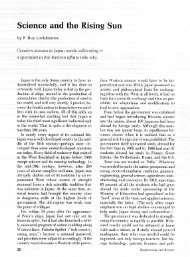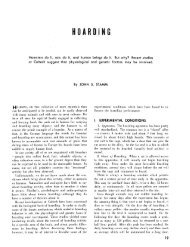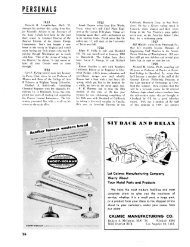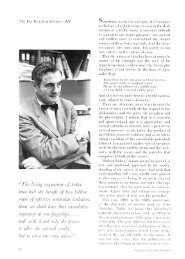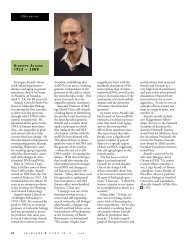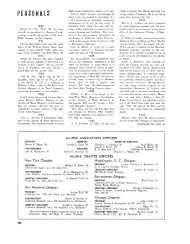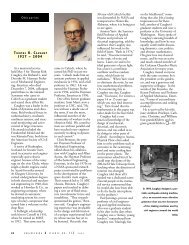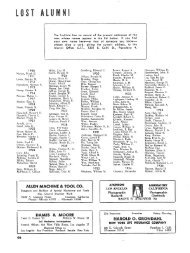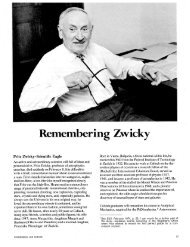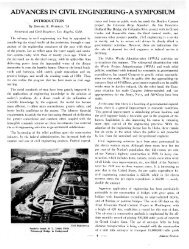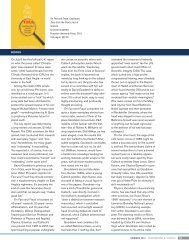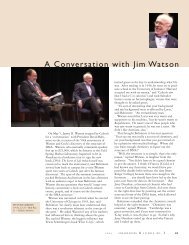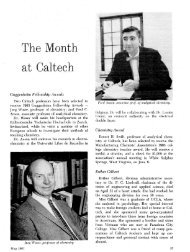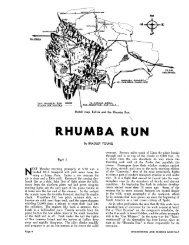The First Operation Under Ether - Engineering & Science
The First Operation Under Ether - Engineering & Science
The First Operation Under Ether - Engineering & Science
You also want an ePaper? Increase the reach of your titles
YUMPU automatically turns print PDFs into web optimized ePapers that Google loves.
talked reform but practiced barbarism. And in<br />
these portraits, pain was portrayed as something<br />
the surgeon maliciollsly manipulated. For instance,<br />
in 1840, the j\'ledical Times ran a striking<br />
se ries of "portraits" of the master of tbe London<br />
surgical scene, Robert Liston, professor of su rgery<br />
at University College London. Liston was preeminent<br />
for his speed with the knife and skill<br />
at manipulating it. But even Liston could be<br />
represented as a malicious, maladroit rogue within<br />
the reformist medical press. <strong>The</strong> Medic£t1 Times<br />
portrayed him as an example of old-fashioned<br />
surgeons' unfeeling attitudes to che ir patients.<br />
<strong>The</strong> way it sketched Liston's crude, cruel , and<br />
vulgar personality involved Liston's attitude to<br />
his patients' pain.<br />
<strong>The</strong> article told a dramatic story of a scruggle<br />
between him and a patient on the operacing cable.<br />
During a lithotomy the patient "attempted to<br />
close his limbs in a vain attempt to avoid stretching<br />
the gaping wound" and thereby suffer even<br />
greater pain. H is surgeon shouted, '''Slack your<br />
legs, man; slack your Jegs-or r won't go on.'"<br />
<strong>The</strong>n he "coolly relinquished the operation," and<br />
staced coldly, '''No, I won't go on, ... unless he<br />
loosens his limbs.'" Eventually the patient was<br />
One medical editor protested chat the idea of one person producing inscnsibil-<br />
ity in another was too terrible even to admit into considerarion. rf pain could<br />
really be suspended, he threatened . "the teeth could be pulled from one's head"<br />
without one's even realizing it.<br />
able to relax his legs. Liston then proceeded with<br />
the operation and, telling the patient, "here's your<br />
enemy," removed rhe stone fwm his bladder. <strong>The</strong><br />
article concluded with a scornful summing up:<br />
"His element was blood, and he raised himself<br />
towards the pinnacle of professional renown upon<br />
the mangled trophies of his amputations and the<br />
reeking spoils of the operating theater." One<br />
could only pity the "trembling patients" who<br />
waited to "feel the temper of his knife."<br />
Pain was traditionally a sign of surgeons'<br />
masterful status, like the clotted blood they left<br />
on their aprons. In the eyes of this journalist,<br />
however, the surgeon was a sinister fi gure perversely<br />
vaulting himself to greater power by<br />
making a greater spectacle than necessary of the<br />
patient's pain and his dependence on the surgeon.<br />
In this instance, mental control of another person 's<br />
body was a greater sign of surgical power than<br />
pbysical control. At the same time, though, it<br />
facilitated an indictment of the surgeon. Pain<br />
was crearcd here not as an inevitable part of a<br />
patient's experience, but as an evil that should<br />
be min imized wherever possible. This was the<br />
implicit assumption that made Liston 's manipulation<br />
of his patiems' pain pivotal in the Medical<br />
Times's attempt to discredit him.<br />
Another factor in the controversy over mesmeric<br />
anesthesia was related to Viccorians' fascination<br />
with altered states of mind. Victorians used a<br />
dizzyingly latge vocabulary for suspended animation:<br />
sleep, coma, insensibility, catalepsy, suspended<br />
animation, transient death, human<br />
hibernation, and aneschesia wete only a few of the<br />
terms purporting to describe different conditions.<br />
To Victorians, no single behavior could uncomroversially<br />
be termed "anesthetized." During these<br />
debares it was not easy to decide when a patient<br />
was insensible. If he moaned, critics claimed he<br />
must havc been awake; he had merely forgotten<br />
the experience. If he lay still, critics took his<br />
motionless state as an indication of conscious<br />
control over his body. Similar uncertainty SLUrounded<br />
the question of the patient's testimony,<br />
because of course this would be one state where<br />
you couldn't remain sober as a judge to testify.<br />
At the very moment when you were supposed<br />
to be keeping track of whar was going on, you<br />
became unconscious.<br />
As the years passed, between 1842 and 1846,<br />
mesmerism became increasingly successful. One<br />
major boon to the campaign was the introduction<br />
of mesmerism to India, where a certain kind of<br />
operation was panicularly helped by anesthesia.<br />
<strong>The</strong>se were operations for the removal of large<br />
tumors, or hydroceles, particularly of the scrotum.<br />
Scrotal hydroceles were not uncommon in India<br />
and could g row to enormous sizes (in some cases<br />
the diseased scrotum weighed more rhan the rest<br />
of the individual's body). <strong>The</strong>y were extremely<br />
hard to remove in the years before anesthesia,<br />
because patients usually died of shock on the<br />
operating cable. When mesmeric anesthesia began<br />
to be practiced in India, ir became particularly<br />
well known for its successful application to these<br />
dramatic and horrible cases. Back in Britain,<br />
Vi ctorian assumprions about the "simpleminded"<br />
nature of India's indigenous peoples made rhese<br />
operations into persuasive evidence for the reality<br />
of mesmeric phenomena. According to the<br />
London journal editOrs, the Indian subjects' were<br />
either roo naive or dim-witted to fake the effects.<br />
Ethel' anesthesia<br />
By mid 1846, mesmeric anesthesia looked ·<br />
poised to encer hospitals as a routine surgical technique.<br />
<strong>The</strong>n, in November, the anesthetic properties<br />
of rhe vapor of ether became widely known.<br />
<strong>Ether</strong>'s history was remarkably similar to<br />
mesmerism's: its powers over the body became<br />
known in the late Enlightenmenc, when doctors<br />
were studying the effects on the body of all kinds<br />
of airs. During the first several decades of rhe<br />
ENG t NEE A tNG & ICtENCf NO. is



